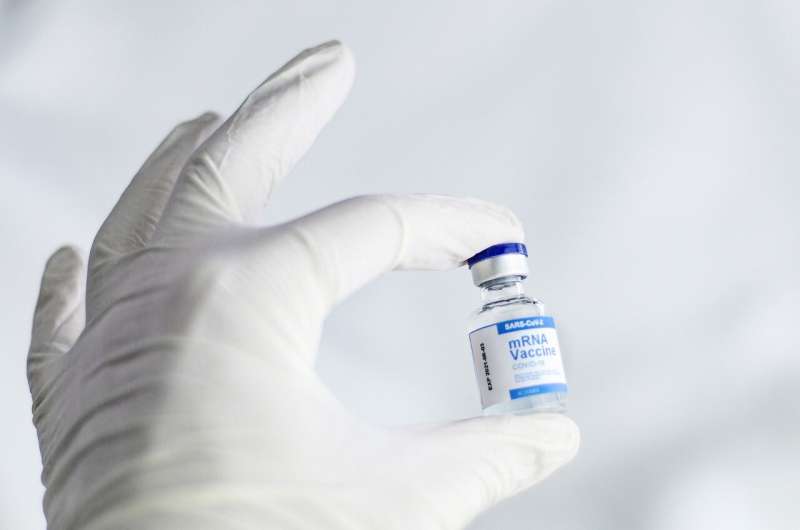Research lab plays pivotal role in new COVID-19 vaccine now in trials

Human clinical trials have begun on a new vaccine candidate that may protect against not only SARS-CoV-2, the virus that causes COVID-19, but against at least two of the variants emerging around the world. The development of this new vaccine was guided by structural information on the virus obtained at the Advanced Photon Source (APS), a U.S. Department of Energy (DOE) Office of Science User Facility at DOE's Argonne National Laboratory, and other light sources.
Trials are taking place at the Walter Reed Army Institute of Research (WRAIR), part of the U.S. Army Medical Research and Development Command, following up on early tests that showed promising results.
"The structural biology work is useful in terms of knowing that the vaccine design is able to bind to protective antibodies, and to see exactly where they bind on the virus. Those two pieces of information are the bread and butter that helped us create the vaccine design."—Dr. Gordon Joyce, chief of the Structural Biology Section at the Henry M. Jackson Foundation for the Advancement of Military Medicine.
The new vaccine, called spike ferritin nanoparticle (SpFN), uses a multifaced sphere design, one that mimics the virus itself, with protruding spikes. In addition to generating a strong immune response, the design of the vaccine may help provide broader protection, shielding against the virus's mutations. Preclinical studies indicate that SpFN induces highly potent and broadly neutralizing antibody responses against the SARS-CoV-2 virus, as well as two major variants—B.1.1.7, first seen in the U.K., and B.1.351, first seen in South Africa—and the SARS-CoV-1 virus, which caused the severe acute respiratory syndrome outbreak in the early 2000s.
Since January of 2020, the APS has made its resources available to the worldwide scientific community for COVID-19 research, and the ultrabright X-rays it generates have helped scientists determine more than 160 structures of the proteins that make up SARS-CoV-2.
"We used the APS to generate high-resolution protein structures, and we used that information as a major component of the pipeline to develop our vaccine," said Dr. Gordon Joyce, chief of the Structural Biology Section at the Henry M. Jackson Foundation for the Advancement of Military Medicine (HFJ), supporting the WRAIR. Joyce developed this new vaccine with Dr. Kayvon Modjarrad, director of the Emerging Infectious Diseases Branch (EIDB) at WRAIR, who leads the Army's COVID-19 vaccine research efforts.
Joyce, Modjarrad and their colleagues used a technique called crystallography—basically shining X-rays onto synthetic protein crystals grown with particular antibodies, to capture detailed pictures of the virus's spike protein—to test whether their nanoparticles have the correct structure and function to elicit an immune response that can neutralize the virus.
"The structural biology work is useful in terms of knowing that the vaccine design is able to bind to protective antibodies, and to see exactly where they bind on the virus," Joyce said. "Those two pieces of information are the bread and butter that helped us create the vaccine design."
Joyce credited the work done at the APS and other light sources around the world with helping to speed up the development of COVID-19 vaccines. He said the long-term research goal involves using crystallography to search for a vaccine against all variants of SARS-CoV-2 and other coronaviruses, in order to get ahead of future outbreaks.
The APS also played a foundational role in the development of all three of the COVID-19 vaccines currently being distributed in the United States.
The phase 1 study of this new vaccine is being conducted at WRAIR's Clinical Trials Center and will enroll 72 healthy adult volunteers ages 18-55. Participants will be randomly placed in placebo or experimental groups. WRAIR is also providing expertise and support to the interagency U.S. Federal Government response aimed at accelerating the development of other COVID-19 vaccines, therapeutics and diagnostics.
"We are in this for the long haul," said Modjarrad. "We have designed and positioned this platform as the next generation vaccine, one that paves the way for a universal vaccine to protect against not only the current virus, but also to counter future variants, stopping them in their tracks before they can cause another pandemic."
More information: Michael G. Joyce et al. Efficacy of a Broadly Neutralizing SARS-CoV-2 Ferritin Nanoparticle Vaccine in Nonhuman Primates, (2021). DOI: 10.1101/2021.03.24.436523



















